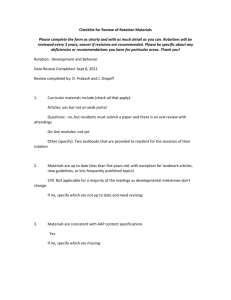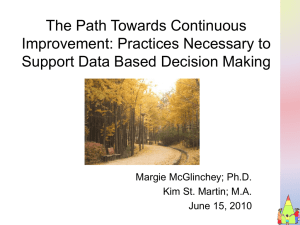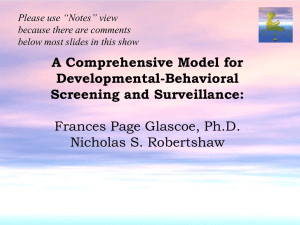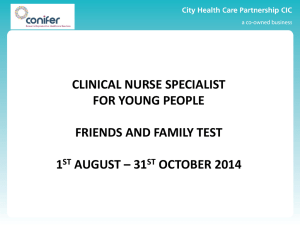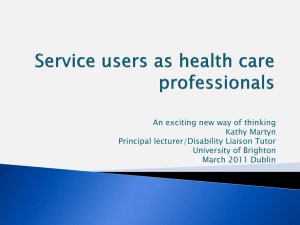Model for Improvement
advertisement
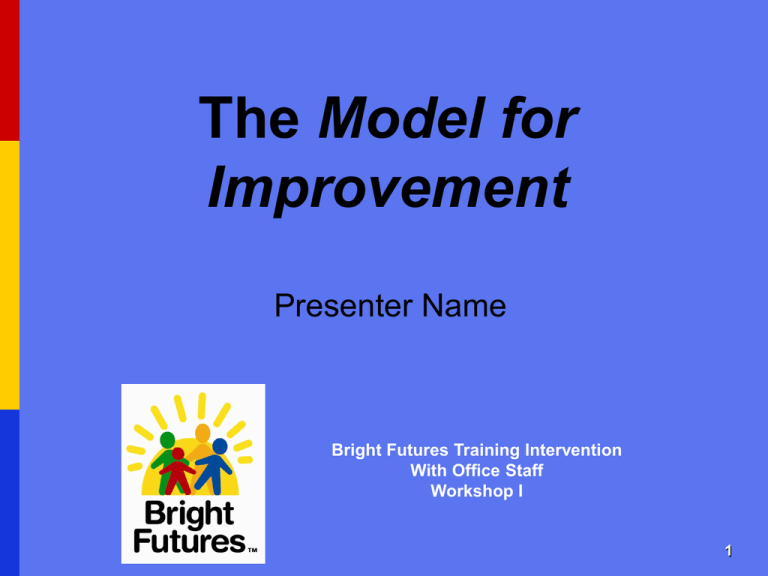
The Model for Improvement Presenter Name Bright Futures Training Intervention With Office Staff Workshop I 1 Session Objectives Gain understanding of the Model for Improvement. Refine team Aim statement. Practice applying the Model for Improvement and Plan-Do-Study-Act methods. 2 3 Fundamental Questions for Improvement What are we trying to accomplish? How will we know that a change is an improvement? What changes can we make that will result in an improvement? 4 Model for Improvement What are we trying to accomplish? How will we know that changes are an improvement? What changes can we make that will result in an improvement? Aim Measures Ideas 5 Model for Improvement Aim What are we trying to accomplish? MEASURES How will we know that changes are an improvement? IDEAS What changes can we make that will result in an improvement? 6 What Are We Trying to Accomplish? Aim Written statement of accomplishments expected from improvement effort 7 Team Aim Should Be A stretch, not business as usual Achievable, not impossible Understandable and clear to others 8 Why Aim for the Moon? “If you aim for the moon, you might reach the top of the telephone pole. If you aim for the top of the telephone pole, you might never leave the ground.” - John Whalley, MD, Mountainview Pediatrics 9 Aim Statements What will be different at the end? Time frame. System to be improved. Setting or subpopulation of patients. Goals. Guidance on how and limitations. 10 Sample Aim Statement By [insert date], Happy Valley Pediatrics will improve the provision of preventive and developmental services to patients younger than 5 years by implementing the Bright Futures framework in our practice. Our office will focus on adopting strength-based counseling strategies and tools, the routine use of structured developmental assessments, forming links with resources in our community, and instituting a recall and reminder system. We will achieve this Aim by using the Bright Futures Implementation and Training tools and materials so that: 1. One hundred percent of charts for children younger than 5 years have preventive services documented on a preventive services prompting sheet. 2. Ninety percent of children younger than 5 years have structured developmental assessments documented in their charts. 3. More than 90% of families with children younger than 5 years have parental strengths and needs assessed at well-child visits. 11 Evaluating Your Practice Aim Does the Aim Describe what will be improved? Seem like a stretch? Seem achievable? Have numeric goals? Describe the system being improved? Describe population of interest and setting? Does it provide guidance (how, limitations)? 12 Model for Improvement AIM: What are we trying to accomplish? MEASURES: How will we know that changes are an improvement? IDEAS: What changes can we make that will result in an improvement? 13 Types of Measures Outcome (Voice of the system) Process (Voice of the processes) Balancing (Voice of caution) 14 Using Measures: Annotated Run Charts Clinician education Reduced appt delays Practice wide guidelines Reminder system 15 Model for Improvement AIM: What are we trying to accomplish? MEASURES: How will we know that change is an improvement? IDEAS: What changes can we make that will result in an improvement? 16 Model for Improvement What are we trying to accomplish? How will we know that a change is an improvement? What changes can we make that will result in improvement? Act Plan Study Do 17 The Plan-Do-Study-Act Cycle for Learning and Improvement Act Act • What changes are to be made? • Next cycle? Study Study • Complete the analysis of the data. • Compare data to predictions. • Summarize what was learned. Plan Plan • Objective. • Questions and predictions. • Plan to carry out the cycle (Who, What, Where, When?). Do Doout the plan. • Carry • Document problems and unexpected observations. 18 Plan-Do-Study-Act Cycles Use Plan-Do-Study-Act cycles to adapt good ideas to your specific situation. Force us to think small. Force us to be methodical, make predictions. Allow rapid adaptation and implementation of changes to your setting. 19 Key Points for Plan-Do-StudyAct Cycles Often the study is specific to the Plan-Do-StudyAct (PDSA) cycle. Linked to goals, but often “downstream” Investigative Usually ends with PDSA cycle Can be qualitative, not just quantitative 20 Key Points for Plan-Do-StudyAct Cycles Initial cycles on smallest scale possible. A “cycle of one” often appropriate “Failed” cycles offer learning Later, test under many conditions. Breakdowns Supports Doubters 21 Tests of Change Changes that result in improvement Ideas 22 Change Principles Use substitution. Match amount to need. Conduct training. Focus on core processes. Work with suppliers. Simplify. Reduce setup and prep time. Practice prevention. Develop backup plans for special situations. Use reminders. 23 Looking for Good Ideas What factors do you face? Identifying children at risk Connecting families with community services 24 Barriers at Many Levels Patient Knowledge about development Stigma Provider Time Counseling resources and skills Practice Process for eliciting concerns Organized materials and resources Referral system 25 Sample Plan-Do-Study-Act Objective: Test using Parents’ Evaluation of Developmental Status with 4 to 5 patients Questions: Will it be hard to integrate into office flow? Will parents like being asked for input? Will length of visit increase? Predictions: Will be successful if front office clips form to patient charts prior to check-in. Will not increase visit length too much. 26 Plan-Do-Study-Act Sample Plan for Test Front office will clip Parents’ Evaluation of Developmental Status (PEDS) to 4 charts of patients younger than 5 years scheduled for visit on Tues/Thurs. Nurse Jayne will collect PEDS from patients prior to Dr Smith conducting physical examination. Plan for Data Nurse will ask patients their opinion. Front office will record visit time. Dr Smith will report on types/number of questions. Nurse will record number of PEDS completed prior to examination. 27 Plan-Do-Study-Act Sample Study One patient could not complete Parents’ Evaluation of Developmental Status (PEDS) on own 3 of 4 prior to examination. Did not significantly increase visit length. Helped to have forms on chart (to remind nurse). Dr Smith reported parents able to articulate chief concern at beginning of visit (instead of at end per usual). All 4 patients liked questions and being asked. Act Nurse will assist patients in completing PEDS in examination room prior to Dr S. Try again with all patients younger than 5 years for 1 week. Continue to track visit length, patient feedback. 28 Breakout Refine Aim. List measures (at least 1 outcome, 3 process, 1 balancing). Generate changes using “change concepts.” Plan first Plan-Do-Study-Act cycle. Report out. 29 Model for Improvement PDSA Planning Worksheet Form for Planning a Plan-DoStudy-Act Cycle Team Name: _____ _____________________________ Cycle: ___________ Date:_________________ PLAN Objective for this cycle: Act Study Plan Do Questions: Predictions: Plan for change or test (Who, What, When, Where?): Plan for collection of data (Who, What, When, Where?): DO Carry out the change or test. Collect data and begin analysis. D escribe observations, problems encountered, and special circumstances. STUDY Complete analysis of data. Summarize what was learned. ACT Are we ready to make a change? Plan for the next cycle. Change Principles Use substitution. Match amount to need. Conduct training. Focus on core processes. Work with suppliers. Simplify. Reduce setup and prep time. Optimize maintenance and prevention. Develop backup plans for special situations. Use reminders. 31 Summary Improvement Principles Miss Frizzle (Magic School Bus): “Take chances, make mistakes, get messy.” 32
